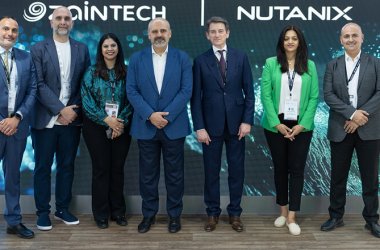
Kaspersky and Saudia Dairy and Food Stuff Company (SADAFCO) joined efforts to share best practices and elevate cybersecurity awareness within the critical infrastructure sector in the Middle East.
According to the ICS CERT landscape report by Kaspersky, malicious objects of all types were detected and blocked on 34% of Industrial Control System (ICS) computers in the first half of 2023. In the Middle East over this period attacks were detected on 36.8% of ICS computers, which is higher than the global average. The top industries under attack were energy (38.4%), oil & gas (31.0%), and manufacturing (21.4%). All these attacks were blocked after detection.
ICS computers are used in oil & gas, energy, automotive manufacturing, building automation infrastructures and other spheres to perform a range of OT functions – from the workstations of engineers and operators to supervisory control and data acquisition (SCADA) servers and Human Machine Interface (HMI). Cyberattacks on industrial computers are considered to be extremely dangerous as they may cause material losses and production downtime for the controlled production line and even the facility as the whole. Moreover, industrial enterprises put out of service can seriously undermine a region’s social welfare, ecology and macroeconomics.
There are different types of cyberthreats that Industrial Control Systems face – malicious scripts, spy trojans, worms, ransomware, among others. The Middle East was one of the regions with the highest percentage of ICS computers on which malicious scripts and phishing pages were blocked in the first half of 2023 (14.3% in the Middle East compared to 12.7% global average). Malicious scripts serve a broad range of goals: from collecting data, tracking and forwarding users to malicious websites, to downloading various malware, such as spyware and/or covert crypto miners, to the system or the browser.
Spyware is another prominent threat for ICS. The Middle East had a high percentage of ICS computers on which spyware was blocked in the first half of 2023 (8.3%).The global average stands at 6.1%.
The Middle East was also one of the regions with the highest percentage of ICS computers attacked by ransomware in the first half of 2023 (0.56% vs. 0.32% global average).
Mission critical applications heavily leveraged within the critical infrastructure sector are often used as gateways or targets of evolving cyberthreats. To mitigate the consequences, ensuring compliance with data privacy legislation in terms of data collection, handling, storage, deletion and governance of third-party partners has become mandatory.
“The food industry is part of the critical infrastructure sector and protecting it against evolving cyberattacks from different threat actors is a national priority in Saudi Arabia. As digital transformation gains momentum, cybersecurity must be a vital consideration, from the product evaluation and development stage, to testing and delivery. While technical defences are crucial, so is awareness among the workforce. We strongly believe that training and education needs to be a continuous process. Our measures at SADAFCO are designed to the highest possible standards and follow three core tenets – cybersecurity training, communication and accountability. We have implemented an annual calendar of targeted cybersecurity training and education activities that are endorsed at all levels of our business management team. We are pleased that we have taken steps to protect our company and thereby contribute to the broader goal of safeguarding critical industries in Saudi Arabia”, said Shrikanth Andali, CIO at Saudia Dairy and Food Stuff Company.
“When it comes to ICS, all world regions have their specifics. The Middle East is a major global energy hub, with numerous critical infrastructure facilities, including oil and gas refineries. Protecting these facilities from cyber threats is of paramount importance to ensure a stable energy supply worldwide. It should also be noted that many Middle Eastern countries are undergoing rapid industrialisation and modernisation, often involving the deployment of new ICS technologies. These systems may not have robust cybersecurity measures in place, making them potential targets,” comments Evgeny Goncharov, Head of Kaspersky ICS CERT. “By understanding the risks related to ICS, organizations can make informed decisions, allocate resources wisely, and efficiently fortify their defences. In doing so, they not only protect their bottom line but also contribute to a safer and more secure digital ecosystem for all”.
To understand more about the ICS threat landscape, meet the Kaspersky experts at Stand H25-A30, Hall 25 at GITEX Global 2023, or read more here.
To keep your OT computers protected from various threats, Kaspersky experts recommend:
- Conducting regular security assessments of OT systems to identify and eliminate possible cyber security issues.
- Establishing continuous vulnerability assessment and triage as a basement for effective vulnerability management process. Dedicated solutions like Kaspersky Industrial CyberSecurity may become an efficient assistant and a source of unique actionable information, not fully available in public.
- Performing timely updates for the key components of the enterprise’s OT network; applying security fixes and patches or implementing compensating measures as soon as it is technically possible is crucial for preventing a major incident that might cost millions due to the interruption of the production process.
- Using EDR solutions such as Kaspersky Endpoint Detection and Response for timely detection of sophisticated threats, investigation, and effective remediation of incidents.
- Improving the response to new and advanced malicious techniques by building and strengthening your teams’ incident prevention, detection, and response skills. Dedicated OT security trainings for IT security teams and OT personnel is one of the key measures helping to achieve this.
To equip your organisation with the right knowledge and tools, SADAFCO recommends:
- With one wrong click potentially having major security consequences, educating and training the workforce must be a priority; it is the first line of defence against malicious attacks.
- Implement robust Environmental, Social, and Corporate Governance (ESG) practices that ensure strategic and operational alignment across all parts of the business.
- Review and evaluate cybersecurity and data privacy governance processes.
- Track your company KPIs against committed ESG metrics.
- Maintain transparency on cybersecurity measures across all levels of the workforce via regular corporate communications.





